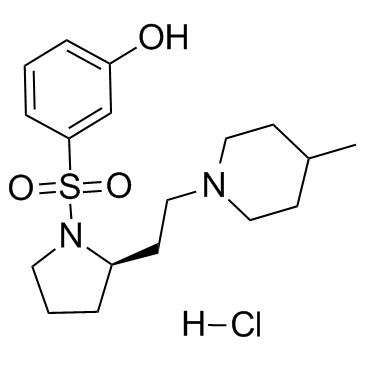8-OH-DPAT acts on both 5-HT1A and 5-HT7 receptors to induce hypothermia in rodents.
Peter B Hedlund, Lisa Kelly, Curt Mazur, Timothy Lovenberg, J Gregor Sutcliffe, Pascal Bonaventure
文献索引:Eur. J. Pharmacol. 487(1-3) , 125-32, (2004)
全文:HTML全文
摘要
Studies using selective drugs and knockout mice have demonstrated that the 5-HT(7) receptor plays an instrumental role in serotonin-induced hypothermia. There is also evidence supporting an involvement of the 5-HT(1A) receptor, although mainly from studies using 8-hydroxy-2(di-n-propylamino)tetralin (8-OH-DPAT), a 5-HT(1A/7) receptor agonist. Here we studied the effects of 8-OH-DPAT and selective antagonists for the 5-HT(1A) and 5-HT(7) receptors on body temperature in rats, wild-type (5-HT(7)(+/+)) mice and knockout (5-HT(7)(-/-)) mice. At lower doses (0.3-0.6 mg/kg, i.p.), 8-OH-DPAT decreased body temperature in 5-HT(7)(+/+) mice but not in 5-HT(7)(-/-) mice. At a higher dose (1 mg/kg, i.p.) 8-OH-DPAT induced hypothermia in both 5-HT(7)(-/-) and 5-HT(7)(+/+) mice. The 5-HT(1A) receptor antagonist (S)-N-tert-butyl-3-(4-(2-methoxyphenyl)piperazine-1-yl)-2-phenylpropanamide (WAY-100135) (10 mg/kg, i.p.) inhibited the effect of 8-OH-DPAT at all doses in rats and mice. In 5-HT(7)(+/+) mice the selective 5-HT(7) receptor antagonist (R)-3-(2-(2-(4-methylpiperidin-1-yl)-ethyl)pyrrolidine-1-sulfonyl)phenol (SB-269970) (10 mg/kg, i.p.) fully inhibited the hypothermia induced by 0.3 mg/kg 8-OH-DPAT, but not that of higher doses. In rats, SB-269970 caused a 60% inhibition of the hypothermia induced by 0.3 mg/kg 8-OH-DPAT. Thus, both 5-HT(7) and 5-HT(1A) receptors are involved in a complex manner in thermoregulation, with the 5-HT(7) receptor being more important at lower, possibly more physiological, concentrations.
相关化合物
| 结构式 | 名称/CAS号 | 分子式 | 全部文献 |
|---|---|---|---|
 |
SB-269970盐酸盐
CAS:261901-57-9 |
C18H29ClN2O3S |
|
A novel, potent, and selective 5-HT(7) antagonist: (R)-3-(2-...
2000-02-10 [J. Med. Chem. 43(3) , 342-345, (2000)] |
|
Characterization of SB-269970-A, a selective 5-HT(7) recepto...
2000-06-01 [Br. J. Pharmacol. 130(3) , 539-48, (2000)] |
|
[(3)H]-SB-269970--A selective antagonist radioligand for 5-H...
2000-05-01 [Br. J. Pharmacol. 130(2) , 409-17, (2000)] |
|
Vasoconstrictor and vasodilator responses to tryptamine of r...
2012-04-01 [Br. J. Pharmacol. 165(7) , 2191-202, (2012)] |
|
Effects of the selective 5-HT7 receptor antagonist SB-269970...
2013-01-01 [PLoS ONE 8(6) , e66695, (2013)] |